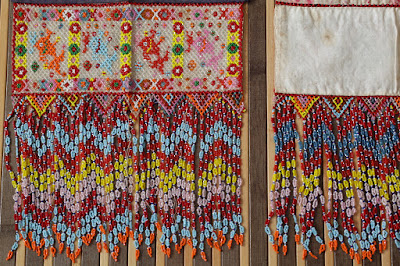Pictures below showing a pair of late 19th century Straits Chinese bead work panels which were used to decorate the opened curtains (besides using the curtain hooks) for bridal chamber and most particularly the bridal bed. It is believed that this pair was owned by a wealthy Peranakan household from Palembang, South Sumatra, Indonesia.
The very small beads used in this piece suggest that it is an earlier example of Nyonya bead work. Later bead work produced into the twentieth century used larger beads.
The beads are small glass faceted rocaille beads and have remained bright and lustrous. There are relatively few discernible losses, with the overall condition being excellent given the age and material used.
Rocaille beads were made in southern France and were widely used in the Straits Settlements, East Sumatra and Java for beading wedding bed ornaments, slippers, wedding pillow ends, betel set mats and other paraphernalia associated with Baba and Nyonya culture. In the Straits Settlements, they were referred to as manek potong (cut beads). They were usually acquired from the street peddlers and specialist merchants for the purpose of beading and embroidery.
These rectangular panels comprises two parts, where the upper parts were decorated with peonies and phoenixes using forbidden stitch on the white silk ground, while the lower parts were finely beaded in the Nyonya or Straits Chinese style with fish motifs, finished with beaded lace and pendant tassels.
Palembang is one of the oldest cities in Indonesia. It was the old capital of Srivijaya, a powerful Malay kingdom, which influenced much of Southeast Asia. It has long had contact with China. The first record of its existence was that of a Chinese monk Yijing, who described his visit there in the seventh century. It developed into a cosmopolitan port city and so the local culture evolved as a syncretic blend of Malay, Arab, Minangkabau, Bugis, Javanese and Chinese influences. The local Chinese became particularly integrated and localized. Conversely, the local Malays acquired many Chinese influences. The panels here amply demonstrate that with the Chinese forma and themes. Indeed, they might have been used either by the indigenous people or the localized Peranakan Chinese.
Size : 22cm x 30cm each
The very small beads used in this piece suggest that it is an earlier example of Nyonya bead work. Later bead work produced into the twentieth century used larger beads.
The beads are small glass faceted rocaille beads and have remained bright and lustrous. There are relatively few discernible losses, with the overall condition being excellent given the age and material used.
Rocaille beads were made in southern France and were widely used in the Straits Settlements, East Sumatra and Java for beading wedding bed ornaments, slippers, wedding pillow ends, betel set mats and other paraphernalia associated with Baba and Nyonya culture. In the Straits Settlements, they were referred to as manek potong (cut beads). They were usually acquired from the street peddlers and specialist merchants for the purpose of beading and embroidery.
These rectangular panels comprises two parts, where the upper parts were decorated with peonies and phoenixes using forbidden stitch on the white silk ground, while the lower parts were finely beaded in the Nyonya or Straits Chinese style with fish motifs, finished with beaded lace and pendant tassels.
Palembang is one of the oldest cities in Indonesia. It was the old capital of Srivijaya, a powerful Malay kingdom, which influenced much of Southeast Asia. It has long had contact with China. The first record of its existence was that of a Chinese monk Yijing, who described his visit there in the seventh century. It developed into a cosmopolitan port city and so the local culture evolved as a syncretic blend of Malay, Arab, Minangkabau, Bugis, Javanese and Chinese influences. The local Chinese became particularly integrated and localized. Conversely, the local Malays acquired many Chinese influences. The panels here amply demonstrate that with the Chinese forma and themes. Indeed, they might have been used either by the indigenous people or the localized Peranakan Chinese.
Size : 22cm x 30cm each








No comments:
Post a Comment